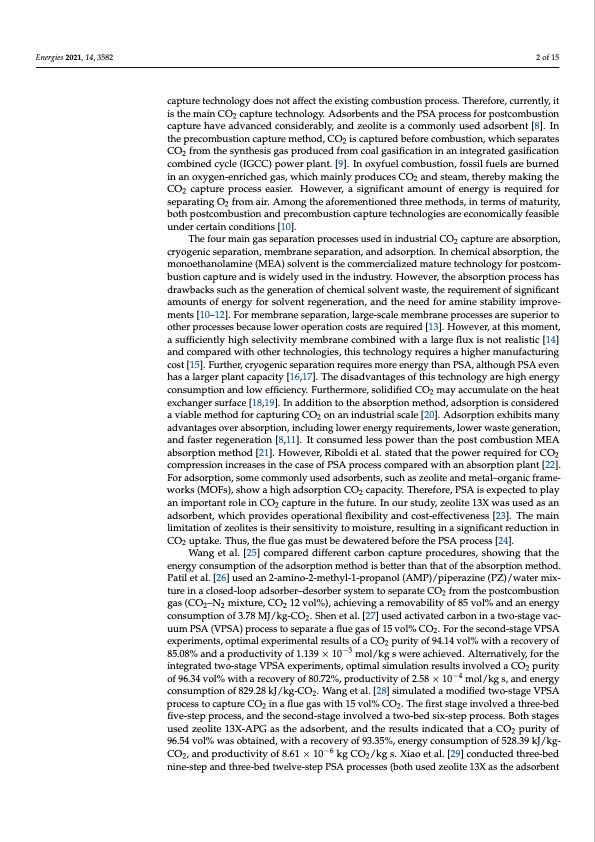
PDF Publication Title:
Text from PDF Page: 002
Energies 2021, 14, 3582 2 of 15 capture technology does not affect the existing combustion process. Therefore, currently, it is the main CO2 capture technology. Adsorbents and the PSA process for postcombustion capture have advanced considerably, and zeolite is a commonly used adsorbent [8]. In the precombustion capture method, CO2 is captured before combustion, which separates CO2 from the synthesis gas produced from coal gasification in an integrated gasification combined cycle (IGCC) power plant. [9]. In oxyfuel combustion, fossil fuels are burned in an oxygen-enriched gas, which mainly produces CO2 and steam, thereby making the CO2 capture process easier. However, a significant amount of energy is required for separating O2 from air. Among the aforementioned three methods, in terms of maturity, both postcombustion and precombustion capture technologies are economically feasible under certain conditions [10]. The four main gas separation processes used in industrial CO2 capture are absorption, cryogenic separation, membrane separation, and adsorption. In chemical absorption, the monoethanolamine (MEA) solvent is the commercialized mature technology for postcom- bustion capture and is widely used in the industry. However, the absorption process has drawbacks such as the generation of chemical solvent waste, the requirement of significant amounts of energy for solvent regeneration, and the need for amine stability improve- ments [10–12]. For membrane separation, large-scale membrane processes are superior to other processes because lower operation costs are required [13]. However, at this moment, a sufficiently high selectivity membrane combined with a large flux is not realistic [14] and compared with other technologies, this technology requires a higher manufacturing cost [15]. Further, cryogenic separation requires more energy than PSA, although PSA even has a larger plant capacity [16,17]. The disadvantages of this technology are high energy consumption and low efficiency. Furthermore, solidified CO2 may accumulate on the heat exchanger surface [18,19]. In addition to the absorption method, adsorption is considered a viable method for capturing CO2 on an industrial scale [20]. Adsorption exhibits many advantages over absorption, including lower energy requirements, lower waste generation, and faster regeneration [8,11]. It consumed less power than the post combustion MEA absorption method [21]. However, Riboldi et al. stated that the power required for CO2 compression increases in the case of PSA process compared with an absorption plant [22]. For adsorption, some commonly used adsorbents, such as zeolite and metal–organic frame- works (MOFs), show a high adsorption CO2 capacity. Therefore, PSA is expected to play an important role in CO2 capture in the future. In our study, zeolite 13X was used as an adsorbent, which provides operational flexibility and cost-effectiveness [23]. The main limitation of zeolites is their sensitivity to moisture, resulting in a significant reduction in CO2 uptake. Thus, the flue gas must be dewatered before the PSA process [24]. Wang et al. [25] compared different carbon capture procedures, showing that the energy consumption of the adsorption method is better than that of the absorption method. Patil et al. [26] used an 2-amino-2-methyl-1-propanol (AMP)/piperazine (PZ)/water mix- ture in a closed-loop adsorber–desorber system to separate CO2 from the postcombustion gas (CO2–N2 mixture, CO2 12 vol%), achieving a removability of 85 vol% and an energy consumption of 3.78 MJ/kg-CO2. Shen et al. [27] used activated carbon in a two-stage vac- uum PSA (VPSA) process to separate a flue gas of 15 vol% CO2. For the second-stage VPSA experiments, optimal experimental results of a CO2 purity of 94.14 vol% with a recovery of 85.08% and a productivity of 1.139 × 10−3 mol/kg s were achieved. Alternatively, for the integrated two-stage VPSA experiments, optimal simulation results involved a CO2 purity of 96.34 vol% with a recovery of 80.72%, productivity of 2.58 × 10−4 mol/kg s, and energy consumption of 829.28 kJ/kg-CO2. Wang et al. [28] simulated a modified two-stage VPSA process to capture CO2 in a flue gas with 15 vol% CO2. The first stage involved a three-bed five-step process, and the second-stage involved a two-bed six-step process. Both stages used zeolite 13X-APG as the adsorbent, and the results indicated that a CO2 purity of 96.54 vol% was obtained, with a recovery of 93.35%, energy consumption of 528.39 kJ/kg- CO2, and productivity of 8.61 × 10−6 kg CO2/kg s. Xiao et al. [29] conducted three-bed nine-step and three-bed twelve-step PSA processes (both used zeolite 13X as the adsorbentPDF Image | CO2 captured from flue gas using the PSA process

PDF Search Title:
CO2 captured from flue gas using the PSA processOriginal File Name Searched:
energies-14-03582-v2.pdfDIY PDF Search: Google It | Yahoo | Bing
CO2 Organic Rankine Cycle Experimenter Platform The supercritical CO2 phase change system is both a heat pump and organic rankine cycle which can be used for those purposes and as a supercritical extractor for advanced subcritical and supercritical extraction technology. Uses include producing nanoparticles, precious metal CO2 extraction, lithium battery recycling, and other applications... More Info
Heat Pumps CO2 ORC Heat Pump System Platform More Info
| CONTACT TEL: 608-238-6001 Email: greg@infinityturbine.com | RSS | AMP |